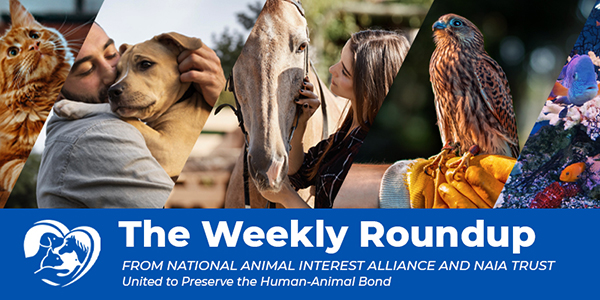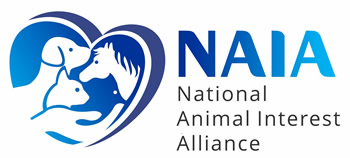
Inside This Issue:
- The Healthy Dog Importation Act Advances
- Edison Who? Animals Have Been Making Their Own Light for over 500 Million Years!
- New Study Helps Debunk Myth of "Sickly" Purebred Dogs
- (Yet Another) Reminder to Leave the Fawns Alone
- Tech Company Promises a Revolution in Fishing
The Healthy Dog Importation Act Advances
Yesterday, Senate Agriculture Committee Chairwoman Stabenow (D-MI) and House Agriculture Committee Chairman Thompson (R-PA) released summaries of their respective versions of the 2024 Farm Bill.
We are pleased to report that Chairwoman Stabenow’s 94-page summary outlines key provisions of the Healthy Dog Importation Act that are included in the Senate version of the Farm Bill. This includes requiring USDA to develop dog importation regulations that provide for electronic document submission, authorizing requirements for vaccinations and parasite treatments, and incorporating greater accredited veterinary oversight. Click below for the full article!
NAIA: The Healthy Dog Importation Act Advances
Edison Schmedison. Animals Have Been Making Their Own Light for over 500 Million Years!
Bioluminescence, the ability of a creature to create its own light, is the beautiful result of millions of years of adaptation. It is stunning to witness in person and has fascinated humans for eons – perhaps because we are boring and had to invent our own lights. Most bioluminescent creatures hail from the darkest depths of the ocean and their light has attracted the curiosity of scientists.
The process of bioluminescence involves a chemical reaction within specialized cells called photophores. These photophores contain luciferin, a light-emitting compound, and an enzyme called luciferase. When luciferin reacts with oxygen in the presence of luciferase, it produces light. The color and intensity of the light emitted can vary depending on the species and the purpose of the bioluminescence. In the deep sea, where sunlight cannot penetrate beyond a certain depth, bioluminescence serves various functions for marine life. It's used for communication, camouflage, attracting prey, and even defense against predators.
So how and why did bioluminescence come about? Marine biology researchers from the Smithsonian and The Monterey Bay Aquarium believe they have found a clue as to how it all began in the bodies of deep sea soft corals. The researchers were able to elicit this response by using a rover equipped with a soft bristled paintbrush. Each time the corals were stroked, they emitted light. Once they were able to identify the species of coral that are bioluminescent, they collected genetic data from them. That data shed new light – pun intended – on the evolutionary age of light up creatures. Previously confirmed to be a glowing shrimp from the Permian era, the new data points to a common ancestor of soft corals from the Cambrian, a whopping 540 million years ago!
The first glow-in-the-dark animals may have been ancient corals deep in the ocean
Resources
★ Illuminating the facts of deep-sea bioluminescence
★ Everything’s Illuminated: 6 Bioluminescent Organisms
New Study Helps Debunk Myth of "Sickly" Purebred Dogs

I'm not just the prettiest dog, I'm also the picture of health. And modest.
A new study out of Texas A&M shows that when it comes to the health of purebred vs. mixed breed dogs, there really isn’t that much difference at all. Further, many of the reasons people take their dogs to veterinarians aren’t tied to breed-specific issues, but rather problems that affect all types of dogs as they wag their way through life: arthritis, allergies, and dental issues. Arthritis wasn’t a surprise, though the other two issues definitely raised an eyebrow. After all, we have long been taught that allergies and dental problems correlate with smaller gene pools and specific breeds. This is the kind of common perception – now misperception – that could cause mixed-breed dog owners to overlook much-needed dental care ("Teeth? Nah, that's a Yorkie issue!"), so it is really important information like this is being shared.
Lately, we have seen a lot of research that challenges popular views – and in some cases, values – when it comes to the well-being of our canine friends. And this is fantastic. Whether it is debunking the oft-repeated mantra that spaying and neutering leads to better health outcomes, or the perception that purebred dogs are inherently “sickly,” it is validating to see research that quantifies what our experience has been telling us for decades. But beyond a sense of validation, there is great value in this data. If we want to improve the health of our furry companions, we can’t use what sounds good and feels “right” as our starting point. We have to begin with a snapshot of reality. Knowing the most common ailments and who is getting them will lead us to the why – and ultimately guide us in how we best prevent and treat these problems.
New Study Dispels Myth That Purebred Dogs Are More Prone To Health Problems
Resources
★ Lifetime prevalence of owner-reported medical conditions in the 25 most common dog breeds in the Dog Aging Project pack
★ The growing debate over spaying and neutering dogs
(Yet Another) Reminder to Leave the Fawns Alone
Friendly reminder: You are not a Disney princess.
The Maryland Department of Natural Resources issued yet another reminder that fawns are not to be touched, moved, or fed. Disturbing baby deer isn't just a bad idea, it is also illegal in most states, so err on the side of caution and please, please, please (and pretty please) just leave them alone. If you spot a fawn, resist the urge to approach it closely. Fawns are often left alone by their mothers for extended periods while the mother goes off to forage. The mother will return periodically to nurse and care for the fawn. Avoid touching the fawn or attempting to move it. Human scent left on the fawn could potentially attract predators or deter the mother from returning - fawns do not have a strong scent. Also, make sure pets are kept indoors or leashed to prevent them from disturbing the fawn.
If you're concerned about the fawn's well-being, you can monitor it from a distance for several hours to see if the mother returns. It's essential to give the mother ample time to return, as she may be nearby but waiting for humans to leave the area before approaching her fawn. It is safe to leave a fawn alone for up to 48 hours, after that, if you believe the fawn is orphaned or injured, contact local wildlife authorities or a licensed wildlife rehabilitator for guidance. They can provide advice on the best course of action and may intervene if necessary. Share your knowledge with others to help prevent a well-intentioned fawn-napping; deer do not do well with being handled and the stress alone could be fatal to the baby. Many people may not be aware that leaving a seemingly unattended fawn alone is often the best course of action for its well-being. Remember, they have survived by being alone during the day and are well-equipped with camouflage, the ability to remain still, and extremely faint scent.
By following these steps, you can help ensure the safety and well-being of any fawns you encounter while respecting their natural behavior and the bond between mother and offspring. Wildlife experts and the deer thank you for this.
Endnote: if this advice sounds like common sense to you (and if you are on our mailing list, it probably does) – great! That means you aren’t the target audience of our “For the love of all that is holy, won’t you please just leave the fawns alone?!” campaigns. That said, it’s important to remember – with a bit of grace, and perhaps less exasperation than we’ve expressed here – that there are lots of folks out there who aren’t blessed with a proper understanding of wildlife behavior and etiquette. Please keep this information in your back pocket for the next time your well-meaning neighbor tries to rescue a perfectly healthy, but seemingly “abandoned” fawn or fledgling.
Keep Maryland’s Wildlife Wild and Safe: Handling Fawns is Dangerous and Illegal
Resources
★ What to do if you find a young deer
★ I Found A Baby Bird. What Do I Do?
Tech Company Promises a Revolution in Fishing

Fish Market
A tech company has created an automated “humane and reliable dispatcher” that prevents fish from slowly suffocating on the decks of fishing boats by, uh, killing them. Essentially, you insert a fish into a machine, which then detects the type of fish and the location of its brain, then the machine shoots a spike through the fish’s head. It sounds rather sterile and gruesome – definitely the type of invention that would have kept J.R.R. Tolkien awake at night – though it is certainly far quicker and more humane than suffocation. Further, this technique reduces incidents of injury and infection in fish that are caught, while increasing shelf-life and overall quality.
The inventor also sells this device on the grounds it could reduce waste and overfishing and create local-level processing jobs. And at least on the surface, the arguments make sense. If the shelf life of fish is extended to a week, rather than a couple days, that would be huge, and mean a lot less waste. And if the value of fish increases while processing costs decrease, that opens opportunities for fishing on a local level, too. Of course, two reasons consumers avoid fish are shelf life and concerns surrounding issues like waste and overfishing. If we see a technological revolution in fishing that eases those concerns, you have to ask if that success might create enough new demand to bring us back to square one, at least on the issue of overfishing.
Shinkei’s humane, quality-preserving fish-harvesting tech could upend the seafood industry
Resources
★ How Long Does Milk Last? Here’s the Real Answer
★ Humane Methods of Slaughter Act
Also in the News...
★ San Diego County's animal welfare groups put out urgent call for assistance (Rescues & Shelters; Overcrowding & Euthanasia; Spay/Neuter; Importing)
★ Louisiana Illuminator: Louisiana senator wants to curb spread of emotional support animals (Spurious ESA Claims; Irresponsible Pet Ownership)
★ Coon Rapids bans sale of cats, dogs at pet stores (Yet Another Pet Store Ban in a Town that Doesn't Have any Pet Stores that Sell Dogs & Cats)
★ Easy EKG For a Chimpanzee (Zoos; Technology-Assisted Animal Care & Welfare; Primatology)
★ Two rabid animals in Raleigh this week. How to get a low-cost vaccine this weekend (Rabies Alert; Get Your Pets Vaccinated!)
★ Zoogeochemists measure how animals change the chemistry of their environments (Ecology, Technology, and Climate Change)
★ Animals on the run: from a runaway racehorse to an escaped circus elephant (Goofy Lists & Videos)
Click here to see what is happening legislatively




